Food Adventure in Sri Lanka
Article and photos by Lies
Ouwerkerk
Senior
Contributing Editor
1/28/2020
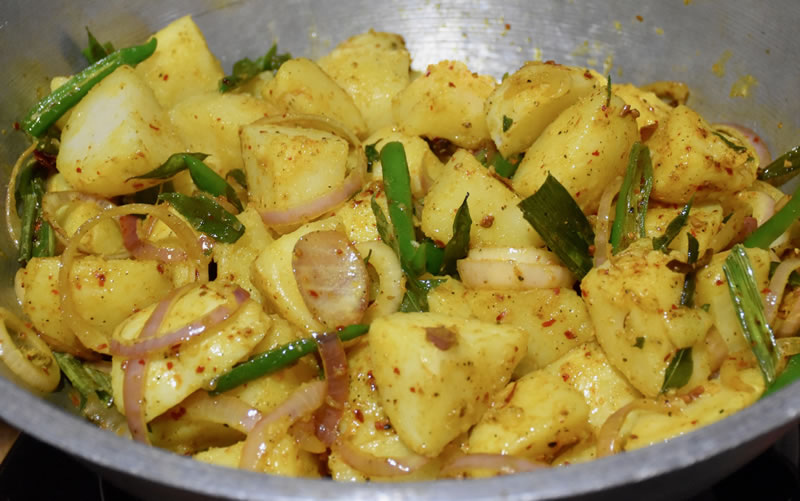 |
| A typical potato
curry made in southern Sri Lanka. |
After the taxi has dropped me off at
my Airbnb in Colombo, my welcoming host suggests we head
straight for Galle Face Green, a large urban park and seaside
promenade. She tells me that you can fill up for pennies
rather than pounds on the most delectable snacks and drinks
at food vendors’ carts. As I will soon join a 12-day road
trip through the country, focusing on anything food, I am
eager to get a heads up on some of Sri Lanka’s famous staples
and do some sightseeing in the island’s capital.
It is early in the evening, and many
Colombo residents pass by after work, for a stroll, watching
the sunset, playing ball, or flying a kite over the open
seafront stretch. What is now a park was originally designed
for military reasons to give cannons a clear line of fire.
Now, inviting smells waft from food vendors’ carts lined
up along the coastline, lit by small electric lights, and
lure passersby to Sri Lanka’s most popular street food.
We drink a delicious faluda, a
milkshake made from wheat vermicelli, sweet basil seeds
(also known as sabja or faluda seeds),
fresh milk, and rose water, served with an ice cream dollop,
and we nibble from staples like appam and kottu.
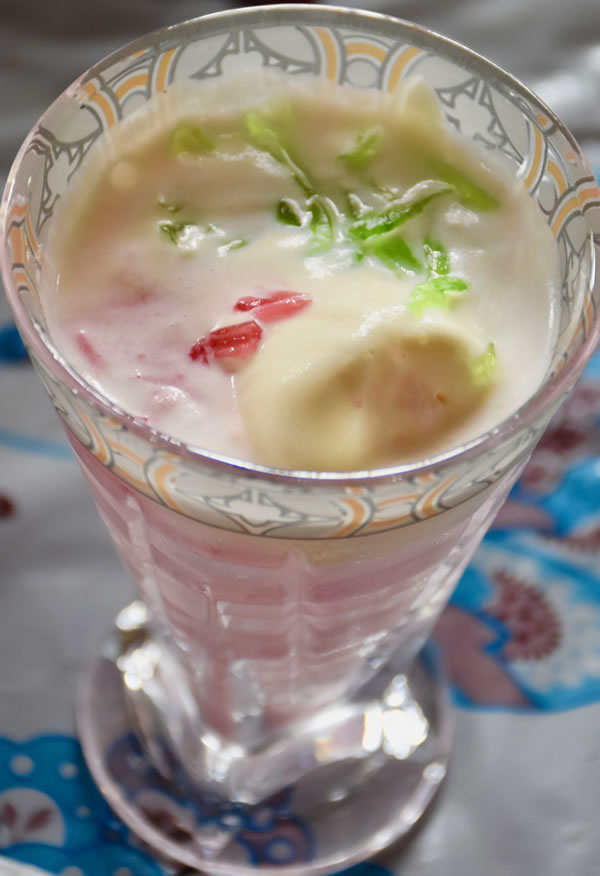 |
| Faluda. |
Appam is a small bowl-shaped,
crispy-edged crepe made with batter from ground rice, coconut
milk and yeast, fermented overnight, and generally called
a "hopper."
Kottu, also known as kottu
roti, is consumed as breakfast, lunch, dinner, or
late-night snack. It consists of onions, cabbage and
other veggies, meat or eggs, and scraps of leftover rotis (wheat
flour flatbread), rhythmically chopped with two metal
pieces each connected to a handle. The mishmash is then
stir-fried with herbs and spices on a hot griddle and
served on a banana leaf together with a curry sauce.
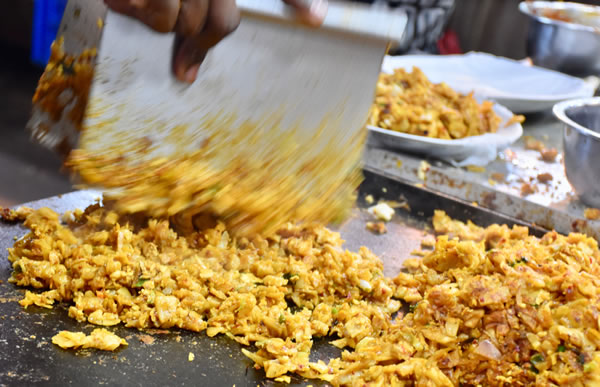 |
| Chopping ingredients
for a kottu. |
Markets
After a day of combing the famous beaches
of Negombo and catching up with jetlag, our guided food
tour through Sri Lanka is on its way. We take off in an
air-conditioned mini-bus, spacious enough for our group
of twelve travelers hailing from Australia, Canada, Ireland,
the UK, Austria, and Italy.
The bustling fish market of Negombo
is a must-see, especially in the early morning hours, when
fishing boats loaded with their fresh catch of the night
are returning to the harbor. Big fishes like stingray, shark,
tuna, barracuda, and sailfish are unloaded, salted, and
left to dry in the sun, or cut up in pieces and sold on
the spot. There are also smaller creatures like sardines,
squid, and a variety of crustaceans. Negombo is not only
close to the sea but also situated near a lagoon and renowned
for its crab, lobsters, and prawns.
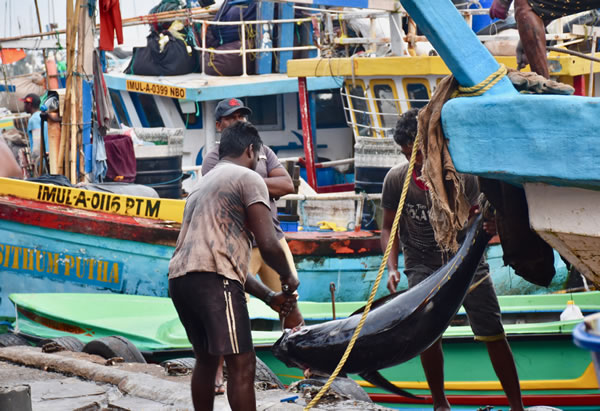 |
| Unloading a fish
in the harbor of Negombo for the market. |
At the wholesale vegetable market in
Dambulla — a city land-inwards, famous for its cave
temples richly decorated with Buddha images, frescoes and
paintings, as well as for the nearby ancient rock fortress
Sigiriya or Lion Rock, a UNESCO-listed World Heritage Site — we
get a real sense of Sri Lanka’s agricultural diversity.
Yams, drumsticks, long beans, different gourd and eggplant
varieties, gotukola (Asiatic pennywort), and betel
leaves are just some of the produce stacked up on the many
trucks heading for Colombo and the rest of the country.
There are plenty of markets in the country
offering locally grown vegetables and fruits. At the Central
Market of UNESCO-listed Kandy, the last capital of the ancient
kings, we get an opportunity to sample from the remarkable
selection of tropical fruits. All are produced in Sri Lanka,
not only the popular fruits like pineapple, mango, strawberries,
and bananas, but also the lesser-known mangosteen, soursop,
rambutan, passion fruit, and cashew apple.
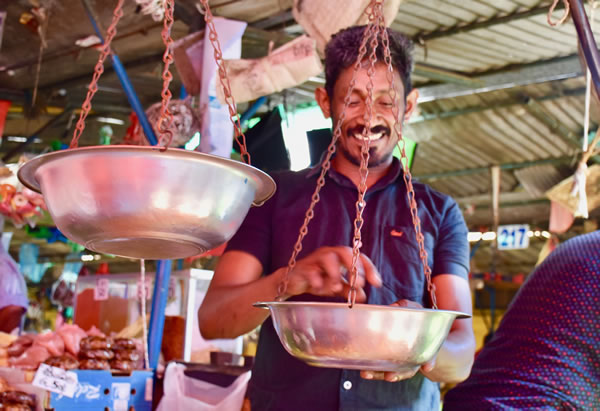 |
| Vendor at Kandy's
fruit market. |
Plantations
At a small family-owned coconut plantation
between Negombo and Dambulla, we learn why the coconut palm,
called "the tree of life," plays such an important
role in Sri Lanka. Not one part of the tree is wasted: the
leaves of the palm tree are used for roofs, its wood for
furniture, the flesh of the coconut for oil and milk, its
clear water for cool drinks, the shell for bowls and handicraft,
the fiber inside the shell for ropes and mats, and the flower
of the tree for nectar, toddy (nectar fermented into palm
wine), and treacle (syrup obtained by boiling nectar for
several hours and then letting it cool — often eaten
with buffalo curd).
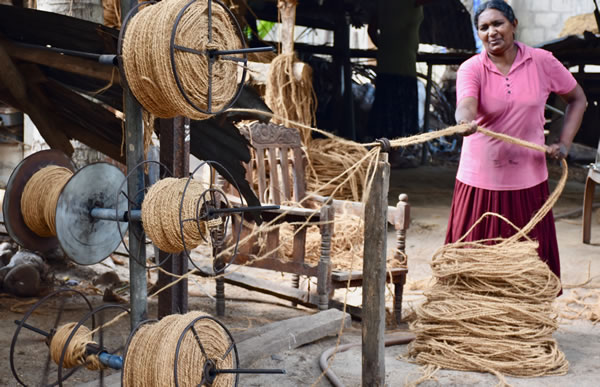 |
| Production of rope
from coconut shell fiber. |
In Sri Lanka, the saying goes: "a
coconut a day, keeps the doctor away," because of
its many perceived health benefits. After we have been shown
how fiber is processed into rope, one of the employees demonstrates
the perilous art of toddy tapping. He climbs in one of the
palm trees using footsteps carved in the trunk, and reaches
a budding flower in the top of the tree, under which he
makes a cut to obtain a white sap that is collected into
mud pots, fastened to the tree around the flower and its
stem. Then he skillfully balances the dangerous tightropes
between the trees to reach other flower buds whose time
is just right.
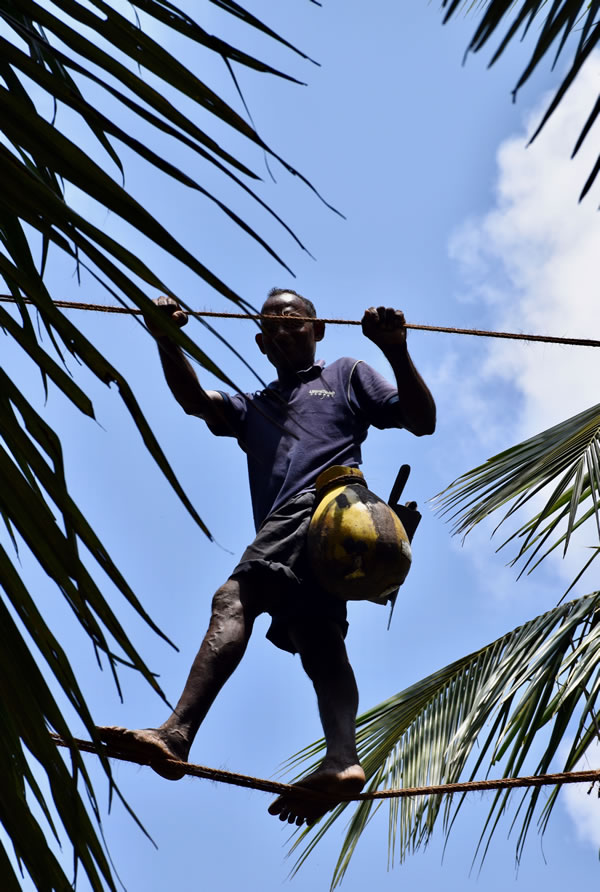 |
| A toddy tapper in
action at a coconut plantation. |
Nowadays, this seasonal trade faces
extinction because of the inherent dangers of dangling high
up in the trees. There are also many jackfruit trees at
this plantation. This healthy green fruit with its thick,
spiky hide, and hundreds of seeds tightly packed together
in the fruit’s flesh, is an important staple in Sri Lanka,
and can be prepared in a variety of ways. The owners of
the plantation treat us on a lunch where we feast on rice
and jackfruit curry, in which the fruit is mixed with onions,
pepper, curry leaves, coconut milk, and spices such as fenugreek,
turmeric, and ground mustard. We learn that cutting jackfruit
trees is nowhere allowed in Sri Lanka. As a consequence,
people who lack the funds to buy their daily rice can always
find jackfruit in nature as a nutritious and free substitute.
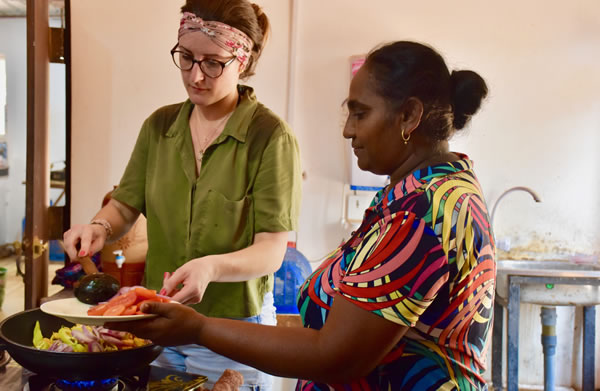 |
| Helping the hostess
to prepare a jackfruit curry. |
In Kandy, we board the train and ride
for hours through the stunning scenery of the Central Highlands,
Sri Lanka’s pre-eminent tea district. The region has the
perfect ecosystem for growing high-quality tea. On our way
to the rural city of Banderawela we pass lush green fields,
and in the surrounding Haputale region we watch tea pluckers
carefully harvesting the tender leaves of Sri Lanka's most
important export product, and carrying heavy baskets on
their backs (they will have to make at least 18 kg a day).
In the adjacent factory, we follow the process of withering,
fermenting, drying, sorting, and packing.
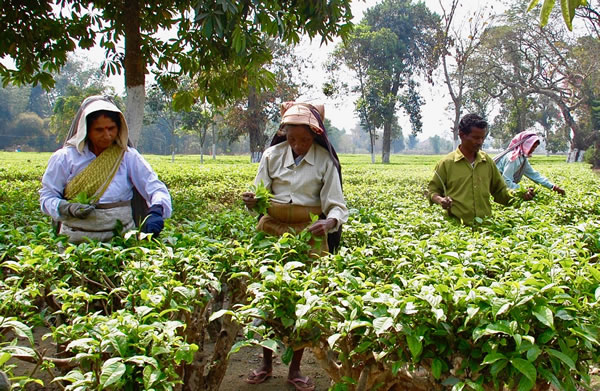 |
| Tea pluckers at
work. |
Sri Lanka, formerly known as Ceylon
when it was a British Crown Colony between 1815 and 1948,
is mostly known for its Ceylon black tea, but also produces
green and white tea. The latter is the most rare and expensive,
due to how it is harvested. White tea is made from the buds
of the tea plant, which are handpicked in the very early
morning before sunrise.
At a farm known for its "chena" cultivation
(the centuries-old method of shifting land, practiced especially
in the dry zones of Sri Lanka), we learn about cultivating
crops such as rice, cereals, grains, yams, and corn. We
enjoy an "al fresco" lunch amid the rice paddies,
feasting on their red rice, tropical vegetables, pumpkin
curry, fried fish caught in a nearby lake, and fresh coconut
drinks to lessen our thirst.
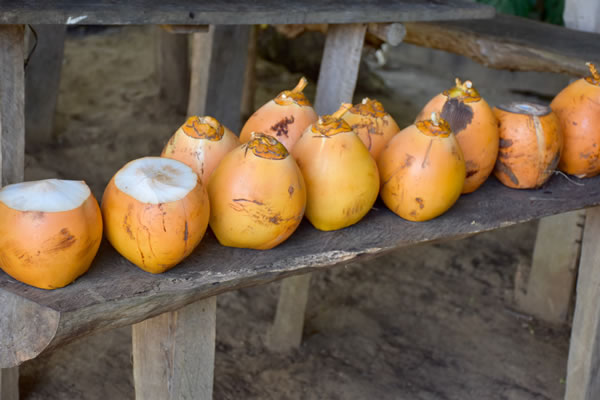 |
| A fresh coconut
drink is awaiting us at a shack in the countryside. |
Rice is undoubtedly the main staple
of Sri Lanka’s population, who consume 100 kg a year per
capita. Brown and red rice are healthier, but most people
use various types of white rice. If there is enough rain,
there could be three crops a year, although two crops during Maha and Yala (monsoon
seasons) are more common.
Rice is not exported, and there is a
minor import of basmati rice from Pakistan.
Cooking and Eating at Locals’ Homes
One of the major attractions of this
food tour is the chance to learn informally about Sri Lanka’s
best recipes, in the homes of locals who open their kitchens
to demonstrate to us their cooking skills and invite us
at their tables afterward.
As represented in Sri Lanka’s flag,
the country’s population is mainly made up of (Buddhist)
Singhalese (73%), (Hindu) Tamil (15%), and Muslim (7%) people,
each with their own culture and customs. This diversity
is also reflected in the choice of families we visit.
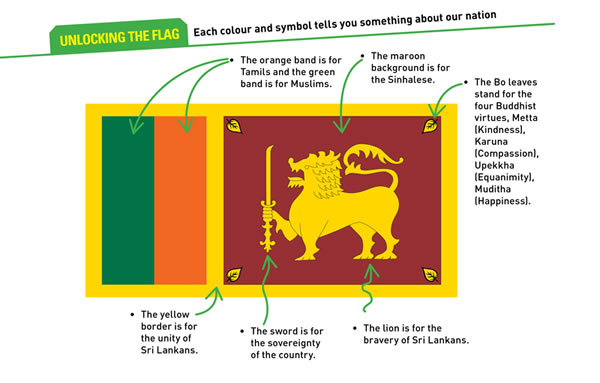 |
| Flag of Sri Lanka. |
A Singhalese family in the outskirts
of Kandy conjures up a classic North Indian curry, and caters
to our sweet tooth with a cooking lesson on desserts, inspired
by traditional Portuguese and Dutch recipes that date back
to the time Portugal ruled the island (1505 – 1658) and
then The Netherlands (1658 – 1796).
One of these originally Dutch desserts
are the delicious waffle-like kokis (Dutch: "koekies," later
anglicized to "cookies"), made with a mold dipped
in batter and then in hot oil, making sure the mold is not
completely submerged.
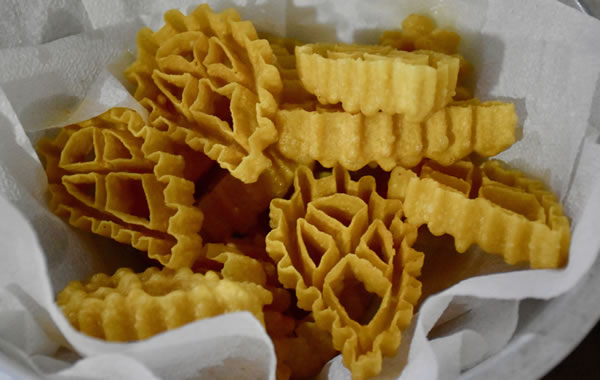 |
| Bowl of kokis. |
We also learn how to make string hoppers
by squeezing batter into a noodle press, after which the
thin noodles are quickly steamed before serving.
In Bandarawela, we enjoy a lunch at
the home of a retired tea plucker who teaches us tricks
from her traditional Tamil cuisine. We eat our heart out
on dosas (crispy rice pancakes), idli (savory
steamed rice cake), and to-die-for deep-fried lentil fritters
served with various chutneys and curry sauces.
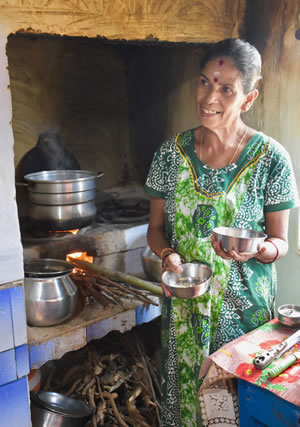 |
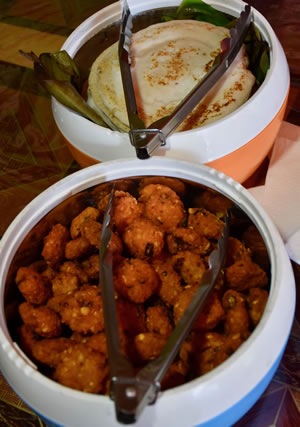 |
| Hostess in her kitchen
baking dosas. |
Deep-fried lentil
fritters and dosas. |
In the southern beach town of Mirissa,
we visit a Muslim family and try watalappam, a
creamy coconut custard pudding dotted with cashew nuts,
sweetened with traditional jaggery and spiced with cinnamon,
cloves, cardomom, and nutmeg. The dessert is said to have
Malay origin, and is particularly popular amongst the Muslim
population in Sri Lanka.
Not far from here, in the town of Galle,
with its many remnants from the Dutch colonial era, we enjoy
a copious meal of fish, crab, eggplant, and potato curries
at the home of a fisherman. He recounts how their lives
have dramatically changed since Sri Lanka was struck by
the disastrous tsunami of 2004, which especially hit this
part of the country.
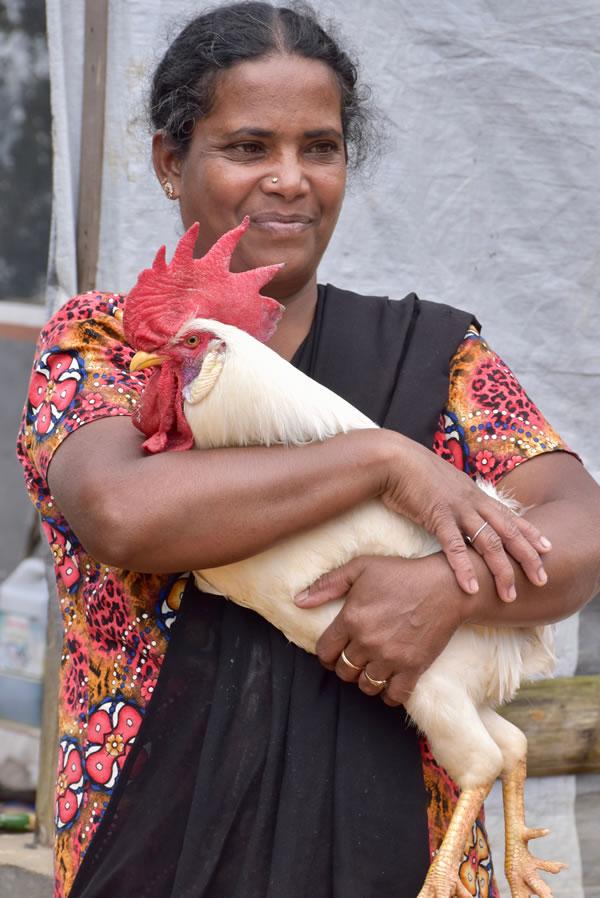 |
| Our hostess in Galle. |
After an exhilarating close-up sighting
of a leopard in Yala Natural Park on Sri Lanka’s southwest
coast, we drive back to Colombo, and conclude this well-rounded
food tour with a traditional "Burgher" or lamprais meal.
For the longest time, I imagined it to be something like
a meat burger, but it turns out to be a traditional dish
kept alive over the centuries by "Burghers" — Portuguese,
Dutch, and British descendants — and consisting of rice,
veggies, and meats, wrapped together in a banana leaf, and
slowly cooked on an open fire.
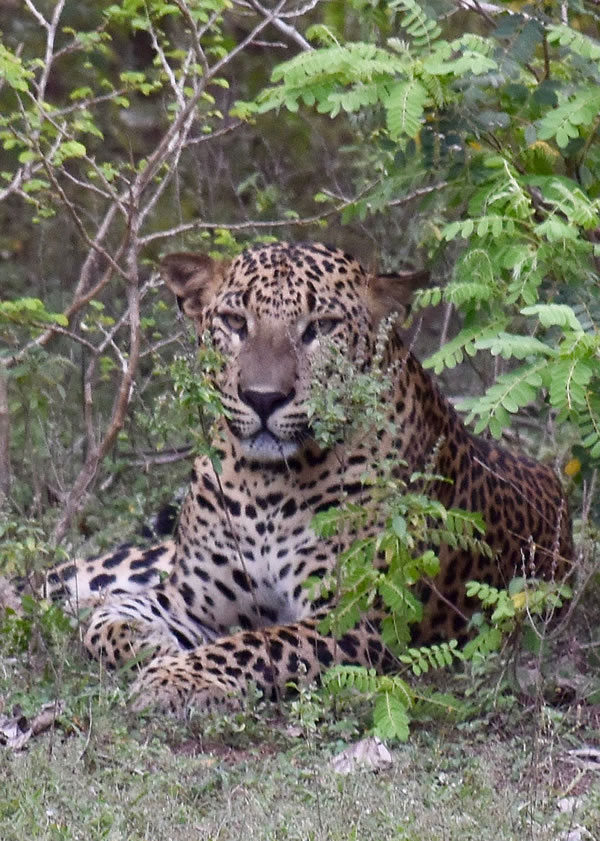 |
| A leopard in Yala
Natural Park sizing us up. |
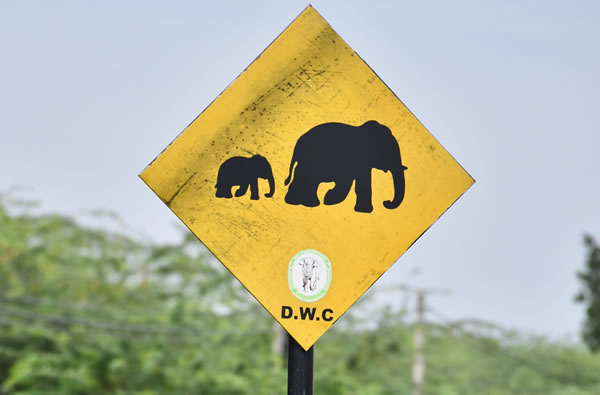 |
| Warning sign along
the road in southern Sri Lanka. |
This enlightening 12-day food tour is
offered throughout the year by Intrepid
Travel.
You may also want to check: The
Ultimate Guide to Sri Lankan Foods: 50 Must Try Dishes and Sri
Lankan Food: 40 of the Island’s Best Dishes.
Lies
Ouwerkerk is originally from Amsterdam,
The Netherlands, and currently lives in Montreal,
Canada. Previously a columnist for The Sherbrooke
Record, she is presently a freelance writer and
photographer for various travel magazines.
|
